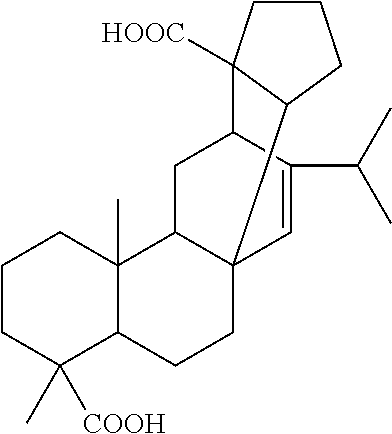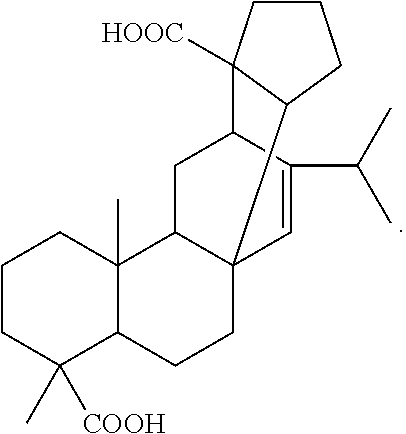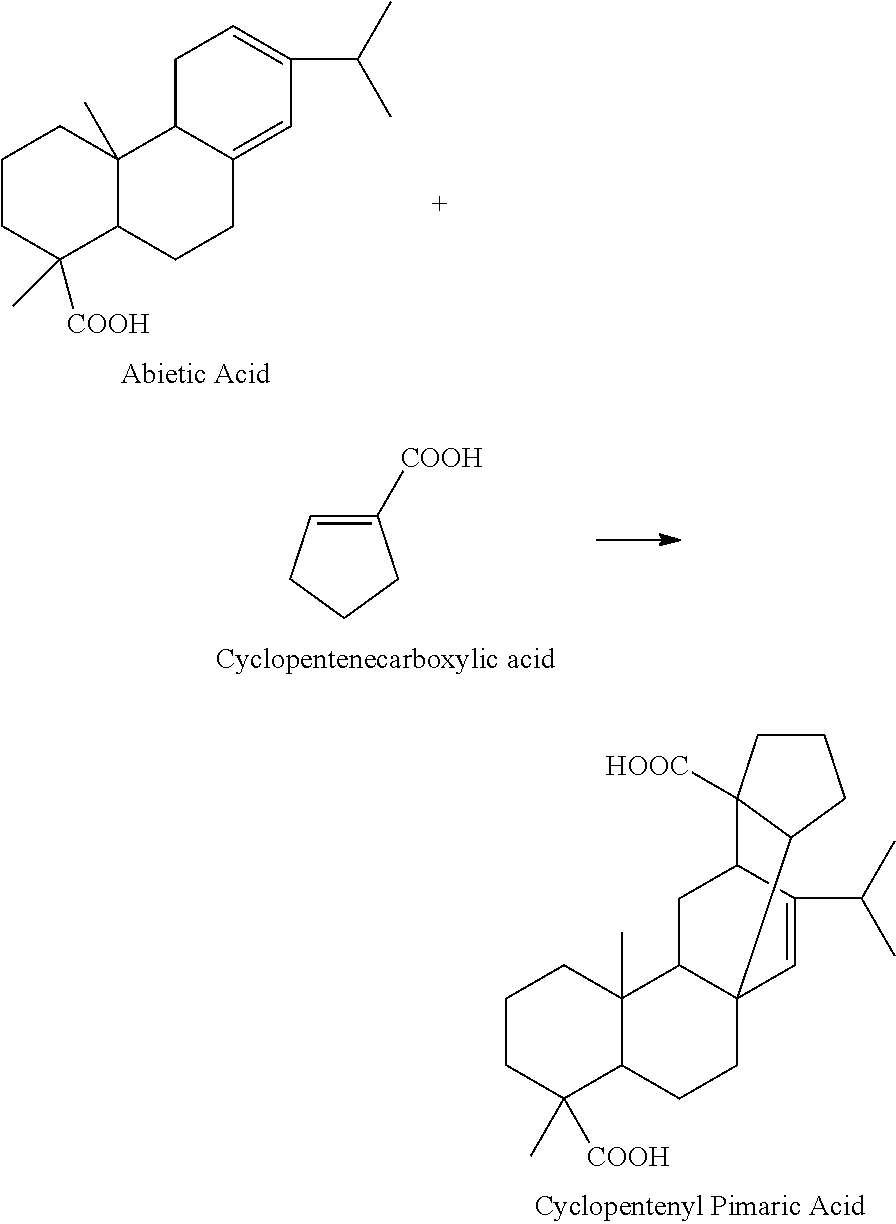Deep-ultraviolet chemically-amplified positive photoresist
a technology of ultraviolet light and positive photoresist, which is applied in the direction of photosensitive materials, instruments, photomechanical equipment, etc., can solve the problems of low efficiency, complex manufacturing process, and lowered resin transparency, and achieve good sensitivity, good transparency, and good sensitivity
- Summary
- Abstract
- Description
- Claims
- Application Information
AI Technical Summary
Benefits of technology
Problems solved by technology
Method used
Image
Examples
example 1
Synthesization Example 1
[0024]50 g of gum resin is added to a four-necked flask equipped with a stirring unit and a condensing unit and heated to a temperature of about 230° C. while a nitrogen gas is introduced into the flask. Then 17 g of cyclopentenecarboxylic acid is added dropwise slowly, and adding time is controlled within 2 hours. After adding of cyclopentenecarboxylic acid is completed, the mixture is continued to react at the temperature of about 230° C. for about 3 hours, then a crude product of cyclopentenyl pimaric acid is obtained by cooling down and discharging from the flask. The crude product is washed once with carbon tetrachloride. The washed product is dried and analyzed. As a result, the softening temperature is in the range of from about 130° C. to about 132° C., and the acid number is about 295 mg KOH / g. The content of the target product measured by High Performance Liquid Chromatography (HPLC) is about 75% by mass.
example 2
Synthesization Example 2
[0025]50 g of gum resin is added into a four-necked flask equipped with a stirring unit and a condensing unit and heated to a temperature of about 210° C. while a nitrogen gas is introduced into the flask. Then 17 g of cyclopentenecarboxylic acid is added dropwise slowly, and adding time is controlled within 5 hours. After adding of cyclopentenecarboxylic acid is completed, the mixture is continued to react at a temperature of about 210° C. for about 4 hours, then a crude product of cyclopentenyl pimaric acid is obtained by cooling down and discharging from the flask. The crude product is washed once with trichloromethane. The washed product is dried and analyzed. As a result, the softening temperature is in the range of from about 130° C. to about 132° C., and the acid number is 295 mg KOH / g. The content of the target product measured by HPLC is about 75% by mass.
example 3
Synthesization Example 3
[0026]50 g of gum resin is added to a four-necked flask equipped with a stirring unit and a condensing unit and heated to a temperature of about 250° C. while a nitrogen gas is introduced into the flask. Then 17 g of cyclopentenecarboxylic acid is added dropwise slowly, and adding time is controlled within 3 hours. After adding of cyclopentenecarboxylic acid is completed, the mixture is continued to react at a temperature of about 250° C. for about 5 hours, then a crude product of cyclopentenyl pimaric acid is obtained by cooling down and discharging from the flask. The crude product is washed once with acetone. The washed product is dried and analyzed. As a result, the softening temperature is in the range of from about 130° C. to about 132° C., and the acid number is 295 mg KOH / g. The content of the target product measured by HPLC is about 75% by mass.
[0027]In a solid film, cyclopentenyl pimaric acid may react with divinyl ether under a heated condition (ab...
PUM
| Property | Measurement | Unit |
|---|---|---|
| temperature | aaaaa | aaaaa |
| temperature | aaaaa | aaaaa |
| temperature | aaaaa | aaaaa |
Abstract
Description
Claims
Application Information
 Login to View More
Login to View More - R&D
- Intellectual Property
- Life Sciences
- Materials
- Tech Scout
- Unparalleled Data Quality
- Higher Quality Content
- 60% Fewer Hallucinations
Browse by: Latest US Patents, China's latest patents, Technical Efficacy Thesaurus, Application Domain, Technology Topic, Popular Technical Reports.
© 2025 PatSnap. All rights reserved.Legal|Privacy policy|Modern Slavery Act Transparency Statement|Sitemap|About US| Contact US: help@patsnap.com



